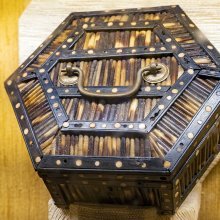Itta, Iṭṭā, Ittā: 6 definitions
Introduction:
Itta means something in Hinduism, Sanskrit, Jainism, Prakrit, biology, Tamil. If you want to know the exact meaning, history, etymology or English translation of this term then check out the descriptions on this page. Add your comment or reference to a book if you want to contribute to this summary article.
Images (photo gallery)
Biology (plants and animals)
Source: Wisdom Library: Local Names of Plants and DrugsItta [इट्टा] in the Marathi language is the name of a plant identified with Rubia cordifolia L. from the Rubiaceae (Coffee) family having the following synonyms: Rubia cordata, Galium cordifolium, Rubia scandens. For the possible medicinal usage of itta, you can check this page for potential sources and references, although be aware that any some or none of the side-effects may not be mentioned here, wether they be harmful or beneficial to health.
Source: Google Books: CRC World Dictionary (Regional names)1) Itta in India is the name of a plant defined with Phoenix acaulis in various botanical sources. This page contains potential references in Ayurveda, modern medicine, and other folk traditions or local practices It has the synonym Phoenix acaulis Buch.-Ham. ex Roxb. (among others).
2) Itta is also identified with Phoenix dactylifera It has the synonym Palma major Garsault (etc.).
Example references for further research on medicinal uses or toxicity (see latin names for full list):
· Calcutta J. Nat. Hist. (1845)
· animaux
· Species Plantarum
· Fieldiana, Botany (1958)
· Matiere médicale (1767)
· plantes
If you are looking for specific details regarding Itta, for example pregnancy safety, health benefits, diet and recipes, extract dosage, side effects, chemical composition, have a look at these references.

This sections includes definitions from the five kingdoms of living things: Animals, Plants, Fungi, Protists and Monera. It will include both the official binomial nomenclature (scientific names usually in Latin) as well as regional spellings and variants.
Languages of India and abroad
Sanskrit dictionary
Source: Cologne Digital Sanskrit Dictionaries: Edgerton Buddhist Hybrid Sanskrit DictionaryIṭṭā (इट्टा).—Mahāvyutpatti 7982, probably error for iṅgā, q.v.; compare however aṭṭa.
Sanskrit, also spelled संस्कृतम् (saṃskṛtam), is an ancient language of India commonly seen as the grandmother of the Indo-European language family (even English!). Closely allied with Prakrit and Pali, Sanskrit is more exhaustive in both grammar and terms and has the most extensive collection of literature in the world, greatly surpassing its sister-languages Greek and Latin.
Prakrit-English dictionary
Source: DDSA: Paia-sadda-mahannavo; a comprehensive Prakrit Hindi dictionaryIṭṭā (इट्टा) in the Prakrit language is related to the Sanskrit word: Iṣṭakā.
Prakrit is an ancient language closely associated with both Pali and Sanskrit. Jain literature is often composed in this language or sub-dialects, such as the Agamas and their commentaries which are written in Ardhamagadhi and Maharashtri Prakrit. The earliest extant texts can be dated to as early as the 4th century BCE although core portions might be older.
Kannada-English dictionary
Source: Alar: Kannada-English corpusIṭṭa (ಇಟ್ಟ):—[noun] that which is liked.
--- OR ---
Itta (ಇತ್ತ):—
1) [adverb] towards this side or direction.
2) [adverb] from that time (in the past) onward; reckoning from that time to the current time.
3) [adverb] ಇತ್ತಿತ್ತ [ittitta] ittitta dupl. of itta; ಇತ್ತೀಚಿನ [itticina] ittīcina of recent times; 2. of or belonging to a comparatively later period; ಇತ್ತೀಚೆಗೆ [itticege] ittīcege now-a-days; recently; of late; ಇತ್ತ ದರಿ, ಅತ್ತ ಪುಲಿ [itta dari, atta puli] itta dari, atta puli (prov.) a situation where one is left between two equally unpleasant or dangerous alternatives; ಇತ್ತಿತ್ತ ಬಾ ಅಂದರೆ ಇದ್ದ ಮನೆಯನ್ನು ಕಿತ್ತುಕೊಂಡ [ittitta ba amdare idda maneyannu kittukomda] ittitta bā andare idda maneyannu kittukoṇḍa (prov.) a small amount of compassion to a man not deserving it, might cost you your fortune.
Kannada is a Dravidian language (as opposed to the Indo-European language family) mainly spoken in the southwestern region of India.
Tamil dictionary
Source: DDSA: University of Madras: Tamil LexiconIttā (இத்தா) noun < Arabic iddat. Period of seclusion incumbent on a Muhammadan woman in consequence of the dissolution of her marriage either by divorce or by the death of her husband; வெளியில். வாராமை. புருஷன் இறந் தால் மனைவி நான்குமாதம் பத்துநாள் இத்தா விருக்க வேண்டும். [veliyil. varamai. purushan iran thal manaivi nankumatham pathunal itha virukka vendum.] Muhammadan usage
Tamil is an ancient language of India from the Dravidian family spoken by roughly 250 million people mainly in southern India and Sri Lanka.
See also (Relevant definitions)
Starts with (+64): Ittacattam, Ittacitti, Ittacitticam, Ittacitticar, Ittacitticcaram, Ittacittitirttam, ittacittittatam, Ittada, Ittade, Ittadi, Ittadu, Ittae, Ittaevu, Ittaga, Ittage, Ittahad, Ittahada, Ittahe, Ittahe, Ittai.
Ends with (+1250): Abhihatacitta, Abhijjhitta, Abhinavaprayashcitta, Abhinikkhitta, Abhinirvritta, Abhinisitta, Abhiniveshacitta, Abhinivritta, Abhinnanimitta, Abhipravritta, Abhisampravritta, Abhisamvritta, Abhisitta, Abhivritta, Abhyantaranritta, Abhyasanimitta, Abhyavritta, Abhyupavritta, Acalitacitta, Acami-varicitta.
Full-text (+21): Atta, Ithaa, Ittalagi, Itha, Ishtaka, Ittalu, Ittacattam, Cukoshnam, Kaivarappu, Puli-ittakari, Patan-ittatol, Ittal, Ittakantam, Naka-motiveshti, Naka-moticelai, Cavatippunul, Coruku-pitikatti, Ishta, Samitha, Tottukkatu.
Relevant text
Search found 5 books and stories containing Itta, Iṭṭā, Iṭṭa, Ittā, Itha, Ithaa; (plurals include: Ittas, Iṭṭās, Iṭṭas, Ittās, Ithas, Ithaas). You can also click to the full overview containing English textual excerpts. Below are direct links for the most relevant articles:
Tiruvaymoli (Thiruvaimozhi): English translation (by S. Satyamurthi Ayyangar)
Pasuram 3.9.6 < [Section 9 - Ninth Tiruvaymoli (Connal Virotam)]
Pasuram 4.6.9 < [Section 6 - Sixth Tiruvaymoli (Tirpparai yam ini)]
Pasuram 4.10.5 < [Section 10 - Tenth Tiruvaymoli (Onrum-tevum, ulakum)]
Rig Veda (translation and commentary) (by H. H. Wilson)
Rig Veda 2.13.9 < [Sukta 13]
Who’s Who Among Our Contributors < [January – March, 2004]
The Neighbours < [January – March, 2004]
Semantic Attitudinisation < [July – September, 1985]
Hindu Pluralism (by Elaine M. Fisher)
Sushruta Samhita, volume 3: Sharirasthana (by Kaviraj Kunja Lal Bhishagratna)
